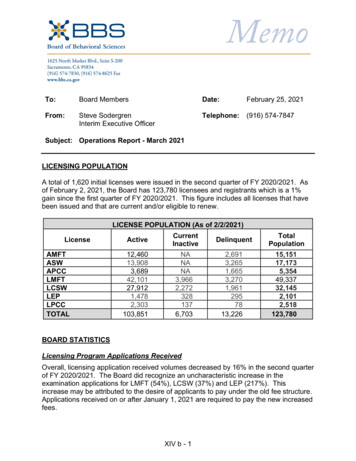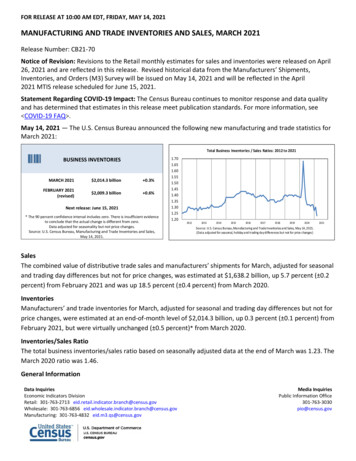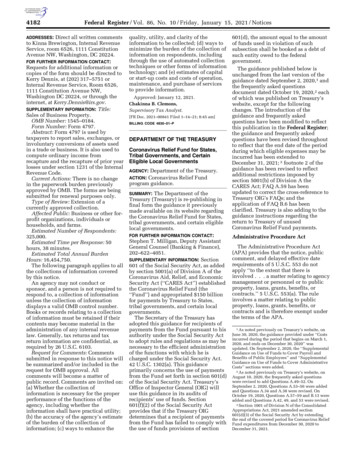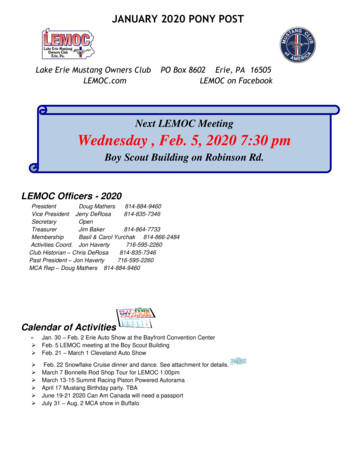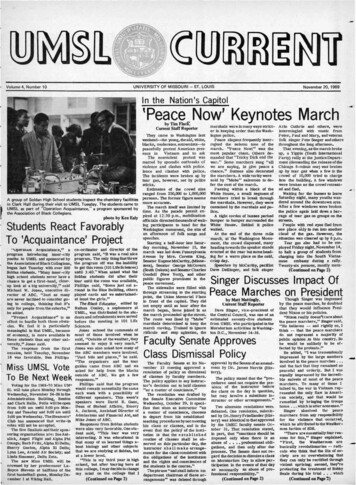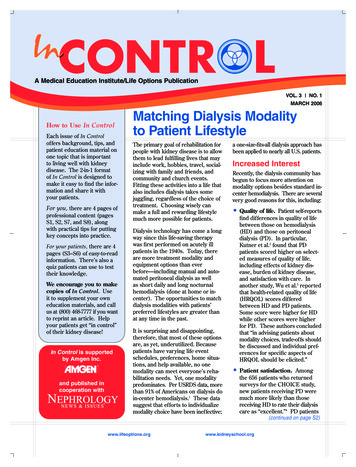
Transcription
InControl Modality3/7/061:28 PMPage 1A Medical Education Institute/Life Options PublicationVOL. 3 NO. 1MARCH 2006How to Use In ControlEach issue of In Controloffers background, tips, andpatient education material onone topic that is importantto living well with kidneydisease. The 2-in-1 formatof In Control is designed tomake it easy to find the information and share it withyour patients.For you, there are 4 pages ofprofessional content (pagesS1, S2, S7, and S8), alongwith practical tips for puttingkey concepts into practice.For your patients, there are 4pages (S3–S6) of easy-to-readinformation. There’s also aquiz patients can use to testtheir knowledge.We encourage you to makecopies of In Control. Useit to supplement your owneducation materials, and callus at (800) 468-7777 if you wantto reprint an article. Helpyour patients get “in control”of their kidney disease!In Control is supportedby Amgen Inc.and published incooperation withMatching Dialysis Modalityto Patient LifestyleThe primary goal of rehabilitation forpeople with kidney disease is to allowthem to lead fulfilling lives that mayinclude work, hobbies, travel, socializing with family and friends, andcommunity and church events.Fitting these activities into a life thatalso includes dialysis takes somejuggling, regardless of the choice oftreatment. Choosing wisely canmake a full and rewarding lifestylemuch more possible for patients.Dialysis technology has come a longway since this life-saving therapywas first performed on acutely illpatients in the 1940s. Today, thereare more treatment modality andequipment options than everbefore—including manual and automated peritoneal dialysis as wellas short daily and long nocturnalhemodialysis (done at home or incenter). The opportunities to matchdialysis modalities with patients’preferred lifestyles are greater thanat any time in the past.It is surprising and disappointing,therefore, that most of these optionsare, as yet, underutilized. Becausepatients have varying life eventschedules, preferences, home situations, and help available, no onemodality can meet everyone’s rehabilitation needs. Yet, one modalitypredominates. Per USRDS data, morethan 91% of Americans on dialysis doin-center hemodialysis.1 These datasuggest that efforts to individualizemodality choice have been ineffective;www.lifeoptions.orga one-size-fits-all dialysis approach hasbeen applied to nearly all U.S. patients.Increased InterestRecently, the dialysis community hasbegun to focus more attention onmodality options besides standard incenter hemodialysis. There are severalvery good reasons for this, including: Quality of life.Patient self-reportsfind differences in quality of lifebetween those on hemodialysis(HD) and those on peritonealdialysis (PD). In particular,Kutner et al.2 found that PDpatients scored higher on selected measures of quality of life,including effects of kidney disease, burden of kidney disease,and satisfaction with care. Inanother study, Wu et al.3 reportedthat health-related quality of life(HRQOL) scores differedbetween HD and PD patients.Some score were higher for HDwhile other scores were higherfor PD. These authors concludedthat “in advising patients aboutmodality choices, trade-offs shouldbe discussed and individual preferences for specific aspects ofHRQOL should be elicited.” Patient satisfaction.Amongthe 656 patients who returnedsurveys for the CHOICE study,new patients receiving PD weremuch more likely than thosereceiving HD to rate their dialysiscare as “excellent.”4 PD patients(continued on page S2)www.kidneyschool.org
InControl Modality3/7/061:28 PMPage 2(continued from page S1)Matching Dialysis Modality to Patient Lifestylewere especially impressed withthe “caring and concern of nurses” and the dialysis staff. Theauthors observed that, “whentreatments provide equivalentsurvival benefits and clinicalefficacy, patients’ views of theirtreatment become more important in choosing among options.” Employment.Given theoption, employed working-agepatients are significantly morelikely to choose “work-friendly”The Full Array of DialysisOptions: Seven ModalitiesStandard In-center Hemodialysis. Patients travel to a dialysis center 3times a week for treatments that last 3–5 hours, on a fixed schedule. Patientsmay or may not do some self-care tasks. Staff monitor the treatments.Conventional Home Hemodialysis.† The patient and a partner trainfor 3–8 weeks* to do 3–5 hour treatments at home, three times/week orevery other day—on their own schedule. Some plumbing/wiring may beneeded in the home.Short Daily Home Hemodialysis.† The patient and a partner train for3–6 weeks* to do treatments at home. Most do 1.5–3 hour treatments5–6 days a week, in the morning, at night—or whenever it is convenientto fit it in. Some plumbing/wiring may be needed.Nocturnal Home Hemodialysis.† The patient and a partner train for 6–8weeks.* Treatments are done at night while the patient sleeps (8 hours, 3–6nights per week), leaving their days free. Extra taping secures the needlesand lines, and bedwetting alarms are used to detect bleeding. Some centers monitor remotely via the Internet. Plumbing/wiring may be needed.Nocturnal In-center Hemodialysis. Patients travel to the center 3times a week or every other night, on a fixed schedule, to do dialysiswhile they sleep. Each session lasts about 8 hours. Staff monitors thetreatment.Continuous Ambulatory Peritoneal Dialysis (CAPD).† The patient doesmanual PD exchanges several times a day, 7 days a week. Training takes1–2 weeks. CAPD can be done without a partner; a clean area and roomfor storage are needed.Continuous Cycling Peritoneal Dialysis (CCPD)/AutomatedPeritoneal Dialysis (APD).† Patients use a cycler to do exchanges atnight for 8–10 hours, while the patient sleeps. Some patients also do oneor two manual exchanges during the day. CCPD may be done with orwithout a partner; a clean area and room for storage are needed.*Length of training time depends on the machine used.†Patients come to the center once a month for blood tests and check-ups. Dialysis staffare available by phone for trouble-shooting.treatment modalities, such astransplant or PD, that permitflexible scheduling and reducethe ups-and-downs in day-to-daysymptomology.5 Patients whokeep their jobs have betterphysical functioning, improvedself-esteem, less depression,higher income that allows themto follow their treatment plan,and, in many cases, an employergroup health plan—whichimproves the payer mix fortheir centers, as well.6 Patient preference.Mostnephrologists and dialysis careproviders believe that patientchoice should play a role in theselection of a treatment for kidneyfailure.7 Further, research hasdemonstrated that when patientsknow about all of the modalityoptions, more of them are likelyto choose PD.8 Schreiber et alfound among 11,000 patients thatpredialysis modality educationincreased the percent of patientschoosing home dialysis (PD) to40%.9 Who makes the choice ofmodality is a vital question: afinding of the DMMS Wave 2study was that patients whochose a treatment themselveshad significantly lower mortality(p 0.0001) and higher transplantrates (p 0.0001) than patientswhose doctors chose for them, oreven those who partnered withtheir doctor in the decision.10Barriers to changeWith so much evidence on theside of offering patients a complete(continued on page S4)S2www.lifeoptions.orgwww.kidneyschool.org
InControl Modality3/7/061:28 PMPage 7Q & A:Ask the ExpertsAn interview with Anne Campbell, MSPH, CHESPatient Education Coordinator, DCI, Columbia, MissouriQ: You’ve been a patienteducator for a long time.Is the modality decisionmaking process differenttoday than it was yearsago?A: Absolutely! The whole modelhas changed. In the past, decisionswere more likely to be made byhealthcare providers. Today, there’sbeen a shift toward more patientinvolvement in decisions. For themost part, I think the change isa good one. At the same time,I realize that making decisions isstressful—especially if you areill. For some patients, the addedresponsibility is a burden, andthere are some who want directguidance. Still, in the end, I thinkthat patients who do the learningand make an informed choicefor themselves are better off.Q: Once patients havelearned the facts, howdo you help them makea choice about dialysismodality?A: After we’ve discussed all thetreatment options in some detail,I like to ask my patients to “tryon” the therapy that they thinkmight work for them. I usuallystart by building on somethingI’ve learned about them. Forexample, to a working personwith school-age children I mightsay, “You seem really busy. Howwould your daily schedule needto change if you were going todialysis 3 times a week? Whatwould you have to do to make itwork?” Asking patients to imagine what their life would be likewith a particular therapy helpsthem to think about it in practical,personal terms. As they walkthrough the details, they beginto get a real picture of exactlywhat they would have to change;they begin to “own the therapy”and can make a more informeddecision about whether it’s agood fit for them.Q: Are there limits towhat education can doto help patients make agood choice?A: Not all patients have a fullrange of choices. Even whenthey do, education can only helpwith the cognitive side of thedecision. There’s an emotional—even visceral—side to making adecision, too. I’ve had patientssay to me, “Don’t even talk to meabout a catheter, I don’t want atube coming out of me.” I’ve hadothers who rule out hemodialysisbecause they’ve known someone—usually a relative—who hadtrouble with hemo. Patients don’tcome to us with a blank slate;many have biases. Educationmay or may not influence awww.lifeoptions.orgpatient’s feelings, emotions,and biases. It’s difficult to seepatients eliminate therapiesthat could provide good medicalresults. In those situations, thebest we educators can do isprovide a framework for makinga logical decision—even if ourpatients are not open to all theoptions.Q: What is the biggestchallenge you face inteaching patients aboutmodality choices?A: Lack of time. When a patientcomes in needing to start dialysisnext week, it’s just not possible tofollow an ideal dialysis educationprotocol. Ideally, you like tohave several meetings with a newpatient, to have the time to doa good assessment and get toknow a little bit about the person.I prefer to teach about differentmodalities in different sessionsbecause it makes understandinga lot easier. When you don’thave enough time, everythingis different. That’s why earlyreferrals are so important. If Ihave had to compress educationpredialysis, I often continue towork with that patient after theystart their treatments to try tofill in their knowledge gaps. Ifappropriate, we might talk aboutthe fact that changing modalitiesis an option.www.kidneyschool.orgS3
InControl Modality3/7/061:28 PMPage 8Quiz Answers(continued from page S2)Matching Dialysis Modalityto Patient Lifestylearray of treatment options—which would facilitaterehabilitation—why is the U.S. modality distribution solopsided?In practice, clinical considerations play only a minor rolein treatment choices. Although U.S. nephrologistsreported that “large” patient size restricted the use ofPD, they did not consider other factors (diabetes, age,or sex) to favor the use of HD.11 In fact, a group ofleading nephrologists agreed that “most incident ESRDpatients are suitable for either HD or PD.”8 Physicianpreference, often cited as the primary selection driver,may not be a major factor either. Practicing U.S.nephrologists claim that they would prefer to see30%–40% of new patients start dialysis using PD.11One likely cause of the skewed U.S. modality distribution is lack of early referral to a nephrologist.11 In theU.S., 47% of patients start dialysis within one monthof their first visit to a nephrologist.11 These patientsalmost always start treatment with in-center HD.Another likely cause is patients’ lack of awareness thatthere are options besides in-center HD. The DialysisMorbidity and Mortality Study (DMMS; Wave 2) foundthat only about one in four in-center HD patientsreported having been told about PD or home HD.12Patients can’t ask for treatments that suit their lifestylesif they don’t know these other options exist.the use of more self-caretherapies (no final draftat press time), andDaVita at Home hascommitted to makinghome dialysis availableto patients in certain U.S. regions, with growth expected.Efforts like these represent important steps toward making more treatment options available to more patients.References1. U.S. Renal Data System. USRDS 2005 Annual Data Report. Atlas of End-Stage RenalDisease in the United States. National Institutes of Health, National Institute of Diabetesand Digestive and Kidney Diseases: Bethesda, MD; 2005.2. Kutner NG, Zhang R, Barnhart H, Collins AJ. Health status and quality of lifereported by incident patients after 1 year on haemodialysis or peritoneal dialysis.Nephrol Dial Transplant 20:2159-2167, 2005.3. Wu AW, Fink NE, Marsh-Manzi JVR et al. Changes in quality of life duringhemodialysis and peritoneal dialysis treatment: Generic and disease specific measures. J Am Soc Nephrol 15:743-753, 2004.4. Rubin HR, Fink NE, Plantinga LC et al. Patient rating of dialysis care with peritoneal dialysis vs hemodialysis. JAMA 291(6):697-703, 2004.5. Witten B, Schatell DR, Becker BN. Relationship of ESRD working-age patientemployment to treatment modality. J Am Soc Nephrol 15:633A, 2004.6. CKD and job retention. Nephrol News Issues 2(2):S1, 2005.7. Mehrotra R, Marsh D, Vonesh E, Peters V, Nissenson A. Patient education andaccess of ESRD patients to renal replacement therapies beyond in-center hemodialysis. Kidney Int 68(1):378-90, 2005.8. Mendelssohn DC, Blake PG, Burkart J, Golper T, Oreopoulous D. Dialysis modalitydistribution in the United States. (letter to ed) Am J Kidney Dis 37(6):1330, 2001.9. Schreiber, et al. Preliminary findings from the national pre-ESRD education initiative. Nephrol News Issues 14(12):44-6, 2000.10. Stack AG, Martin DR. Association of patient autonomy with increased transplantation and survival among new dialysis patients in the United States. Am J KidneyDis 45(4):730-42, 2005.11. Mendelssohn DC, Mullaney SR, Jung B, Blake PG, Mehta RL. What do Americannephrologists think about dialysis modality selection? Am J Kidney Dis 37(1):2229, 2001.Offering OptionsCaregivers can do several things to improve the likelihood that people with chronic kidney disease will haveaccess to a full range of treatment options:1. Provide thorough, unbiased education about treatment options2. Welcome patient participation in modality choice3. Make a full menu of modalities available in more clinicsThere are signs that the dialysis community is moving toimprove the distribution of dialysis modalities, and moreemphasis will be placed on individualizing modality selection.For example, the draft Statement of Work (3-year ESRDNetwork contract) included language that would encourageS41. True2. False. CCPDis done with amachine calleda cycler.3. True4. True5. Truewww.lifeoptions.org12. U.S. Renal Data System. USRDS 1997 Annual Data Report. USRDS DialysisMorbidity and Mortality (Wave 2). NIH, NIDDK: Bethesda, MD; 2005:p. 53.In ControlContact:Life Options Rehabilitation Programc/o Medical Education Institute, Inc.414 D’Onofrio Drive, Ste. 200Madison, WI 53719Tel: (800) 468-7777Fax: (608) 833-8366E-mail: kidneyschool.orgwww.kidneyschool.org
InControl Modality3/7/061:28 PMPage 3PatientsA Medical Education Institute/Life Options PublicationVOL. 3 NO. 1MARCH 2006You Decide! Choosing a Treatment that Fits Your LifeChoosing a treatment for kidney failuremay feel like the end of the world—butit’s not. In fact, the right treatmentoption can help you keep your preferredlifestyle. Often, people (or doctors)make a quick choice that may not be thebest fit. The key to making the rightchoice for you is:(a) Learn about all of your options(b) Look at your wants, needs, and limitsYour Treatment OptionsYou may have more treatment optionsfor kidney failure than you think: Transplant – a new kidney from adonor (living or deceased) replacesyour kidneys. It can take time to geta transplant. While you wait, youmay need dialysis. Peritoneal dialysis – using the lining ofthe abdomen as a filter to clean the blood: CCPD – doneIn Control is supportedwhile youby Amgen Inc.sleep with amachine calleda “cycler”and published in CAPD – donecooperation withby you, without a machine,4 times a daywww.lifeoptions.org Home hemodialysis – you and a partnerget training and do your treatments athome: Short daily home hemodialysis – done5–7 times a week for 2–3 hours at a time Conventional home hemodialysis – done3 times a week (or every other day) Nocturnal home hemodialysis – done3–7 nights a week, while you sleep In-center hemodialysis – you travelto a center to get your treatments: Conventional – done 3 times a weekfor about 3-4 hours at a time Nocturnal – you sleep in the center3 nights a week and keep your days freeWhen you choose a treatment, you don’thave to stay on it forever. Many peoplechange treatments, for reasons that mayor may not be in their control.Note that some options may not be offeredat your center and/or may not work for you.Talk to your nephrologist and/or dialysisstaff member if you want a certain treatment.Take a Look at Your LifeMany factors go into choosing a treatmentfor kidney failure. You and your nephrologist(continued on page P4)www.kidneyschool.orgP1
InControl Modality3/7/061:28 PMPage 4PatientsMaking the Right Treatment Choice for MeYour treatment can fit your lifestyle. Read howfour other people’s choices suit their lives:Debbie: In-centerHemodialysis (HD)Debbie, 46, has been on in-center HD foralmost a year, sinceher transplant of 17years failed. “Ithought about PD, butwas urgently startedon in-center HD whenmy transplant failed,”she explains. “Itseemed to me that in-center HD was easierto work around than doing a home therapy, because the home therapy would takemore time.”In-center HD also seemed a better fit forDebbie’s family life. “I work from 3:30 p.m.to midnight and my husband works nights,”she explains, “so our time together is duringthe day. I didn’t want to spend the wholemorning doing dialysis at home.” Debbieis on in-center HD 3 days a week from11 a.m. until 2:30 p.m., and sleeps duringher treatment. She then goes to work.Debbie urges people to look closely attheir lives. “Everyone’s situation is different, so you really have to look at yourlifestyle, work, etc., and see what wouldbe a good fit,” she explains. “For example,a retired person may find home dialysiseasier than going to a center three timesa week. The most important thing is toraise your head up and go on with whatyou have to do in life.”P2www.lifeoptions.orgKevin: Daily Home HDJust 18 now, Kevin was born with a bladderproblem that caused his kidneys to fail.Since he has had kidney failure for solong, Kevin has relied on different treatments to meet his needs at any given time.At 5, Kevin received his first transplant.“I had that transplant for 10 years,”explains Kevin. “When it failed, I triedPD but it didn’t work because I had toomuch scarring from previous surgeries.”Kevin had a second transplant in 2003. “Whenit rejected, I began in-center dialysis,” relaysKevin. “I talked with the team abouthome dialysis, and when the clinic starteda home program they chose me to train.”Both Kevin and his care team thoughtdaily home dialysis was a better fit for hislife. Plus, Kevinfeels much bettersince he dialyzes 6days a week for 2 to2.5 hours. “I’m asenior in high schoolnow—I like to hangout with my friends,hunt, and fish,” explains Kevin. “Homedialysis coordinates better with my dayand lets me be more flexible and free.”Mary Ann: Continuous CyclingPeritoneal Dialysis (CCPD)When Mary Ann’s kidneys were failing8 years ago, she considered her options.“Mostly, I chose PD because I worked,”reports Mary Ann. CCPD left her dayswww.kidneyschool.org
InControl Modality3/7/061:28 PMPage 5Patientsfree to work full-time.“I thought about incenter HD,” she says,“but the people lookedso wiped out after theirdialysis. Plus, I didn’thave the time to go inthere 3 times a week. I’ve got work to do!”Now retired, Mary Ann worked for 7 yearson CCPD. “I hooked up to my cycler for8 hours every night and did one manualexchange at work.” Mary Ann got permission to use a small office for her mid-dayexchange. “There really wasn’t much toit,” she says. “I just made sure thingsweren’t dusty, and I always washed myhands and masked.”After 8 years on CCPD, Mary Ann feelsgood and finds her diet and fluid limitseasy to manage. Best of all, she has thefreedom to travel. “If you go on PD, youcan do anything,” she says. She’s been oncruises, and done lots of U.S. travel. MaryAnn likes CCPD so well that she’s decidednot to put her name on the transplant list.“What would be different?” she asks. “I’dstill have to take medications. The onlything I wouldn’t have is boxes of dialysatecrowding my living room,” she laughs.John: Nocturnal Home HDAt 84, John may be the oldest person inthe U.S. doing home dialysis. In late 2002,John was told his kidneys were failing.“He and his wife, Sarah, talked to his doctor about home dialysis, but then John hada setback. “I went into the hospital for awww.lifeoptions.orgheart attack and started dialysis there—much earlier than planned,” John reports.John continued in-center HD, but “didn’t likeit because the schedule messed up everything.” Sarah agrees. “The only time thecenter had was 5 p.m., so our dinner wasinterrupted and we didn’t get home until10:30 or 11 p.m.” In addition, John didn’tfeel very well. “I was cold all the time, verytired, and itching like mad,” he says.John believes in “following how you feel,”and he didn’t feel well on in-center HD.So, he began training for nocturnal homeHD. “We went to classes 5 days a week for6 weeks,” remembers Sarah, “but it wasworth it!” Now, 5 nights a week, John andSarah take an hour to set up the machinebefore bed and 30 minutes to disconnectand clean in the morning. “You wake upfeeling much better and ready to go,”relays John. “Plus, now I have time tomow four acres and garden!”John feels great,doesn’t need bloodpressure drugs, andcan eat most thingssince he gets somuch dialysis. Heattributes feeling better to the longer time (8 hours) and slowerblood flow and pump speed. “I would suggest nocturnal home HD to anyone,” saysJohn. “I think how you feel when firstdiagnosed with kidney failure should guidehow you choose a treatment, and for me[home dialysis] is the way to go!”www.kidneyschool.orgP3
InControl Modality3/7/061:28 PMPage 6Patients(continued from page P1)Choosing a Treatment that Fits Your Lifestylewill look at such factors as your health,your home, and any physical limits youmay have. Be sure to look at your lifestylefactors, like work, an active family life,travel, and/or childcare needs, too.How will your treatment choice fit yourlife? You are the one who will need tomake your treatment work for you.Any option can create some changesin your life. But looking at what’s mostimportant to you will help you choosea treatment that will allow you to livelong and well.Online HelpYou can learn more about the treatmentoptions for kidney failure, and the prosand cons of each, on the Internet at:Treatment and Lifestyle Quiz Kidney School , www.kidneyschool.orgis Life Options’ free, on-line, kidneylearning center. Module 2—TreatmentOptions for Kidney Disease, covers thetypes of treatments and the pros andcons of each. Home Dialysis Central, www.homedialysis.org is a clearinghouse of information on home treatment optionsand centers that offer them.If you don’t have a computer at home,try the library. Or, ask a friend or relative to help you log on so you can usethese valuable resources, and others.Deciding on a treatment is your choice,and it’s one that you have a voice in—it’s your life!Now that you’ve read about choosing a treatment for kidney failure, try to answer thestatements below to see how much you’ve learned (answers are on page S8).1. Travel and work are lifestyle factors to considerwhen choosing a treatment for kidney failure.In Control True FalseContact:2. CAPD is done with a machine called a cycler.Life Options Rehabilitation Program True Falsec/o Medical Education Institute, Inc.414 D’Onofrio Drive, Ste. 2003. Short daily home hemodialysis is done 5–7Madison, WI 53719times a week. True FalseTel: (800) 468-7777Fax: (608) 833-83664. With nocturnal in-center hemodialysis you sleepE-mail: lifeoptions@meiresearch.orgin the center 3 nights a week. True Falsewww.lifeoptions.org5. You don’t have to stay on the same treatmentwww.kidneyschool.orgforever. True FalseP4www.lifeoptions.orgwww.kidneyschool.org
Matching Dialysis Modality to Patient Lifestyle VOL. 3 NO. 1 MARCH 2006 and published in cooperation with A Medical Education Institute/Life Options Publication How to Use In Control Each issue of In Control offers background, tips, and patient education material on one topic that is important to li

